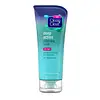What's inside
What's inside
 Key Ingredients
Key Ingredients

 Benefits
Benefits

 Concerns
Concerns

 Ingredients Side-by-side
Ingredients Side-by-side

Water
Skin ConditioningGlycerin
HumectantSodium Laureth Sulfate
CleansingMicrocrystalline Cellulose
AbsorbentCellulose
AbsorbentLauryl Glucoside
CleansingAcrylates/C10-30 Alkyl Acrylate Crosspolymer
Emulsion StabilisingPhenoxyethanol
PreservativeParfum
MaskingMethylparaben
PreservativeMicrocrystalline Wax
Emulsion StabilisingSodium Hydroxide
BufferingMenthol
MaskingDisodium EDTA
Sodium Benzotriazolyl Butylphenol Sulfonate
UV AbsorberUltramarines
CI 73360
Cosmetic ColorantTalc
AbrasiveBlue 1 Lake
Cosmetic ColorantCI 19140
Cosmetic ColorantWater, Glycerin, Sodium Laureth Sulfate, Microcrystalline Cellulose, Cellulose, Lauryl Glucoside, Acrylates/C10-30 Alkyl Acrylate Crosspolymer, Phenoxyethanol, Parfum, Methylparaben, Microcrystalline Wax, Sodium Hydroxide, Menthol, Disodium EDTA, Sodium Benzotriazolyl Butylphenol Sulfonate, Ultramarines, CI 73360, Talc, Blue 1 Lake, CI 19140
Water
Skin ConditioningHydrogenated Castor Oil
EmollientMethyl Gluceth-20
HumectantSodium Laureth Sulfate
CleansingLauryl Glucoside
CleansingDisodium Lauroamphodiacetate
CleansingPEG-80 Sorbitan Laurate
Panthenol
Skin ConditioningDimethicone PEG-8 Meadowfoamate
EmollientPolyquaternium-7
Sodium Benzotriazolyl Butylphenol Sulfonate
UV AbsorberMenthol
MaskingAcrylates/C10-30 Alkyl Acrylate Crosspolymer
Emulsion StabilisingTetrasodium EDTA
Phenoxyethanol
PreservativeIodopropynyl Butylcarbamate
PreservativeSodium Hydroxide
BufferingHydrogenated Jojoba Oil
AbrasiveCI 77007
Cosmetic ColorantCI 42090
Cosmetic ColorantCI 60730
Cosmetic ColorantParfum
MaskingWater, Hydrogenated Castor Oil, Methyl Gluceth-20, Sodium Laureth Sulfate, Lauryl Glucoside, Disodium Lauroamphodiacetate, PEG-80 Sorbitan Laurate, Panthenol, Dimethicone PEG-8 Meadowfoamate, Polyquaternium-7, Sodium Benzotriazolyl Butylphenol Sulfonate, Menthol, Acrylates/C10-30 Alkyl Acrylate Crosspolymer, Tetrasodium EDTA, Phenoxyethanol, Iodopropynyl Butylcarbamate, Sodium Hydroxide, Hydrogenated Jojoba Oil, CI 77007, CI 42090, CI 60730, Parfum
Ingredients Explained
These ingredients are found in both products.
Ingredients higher up in an ingredient list are typically present in a larger amount.
Acrylates/C10-30 Alkyl Acrylate Crosspolymer is a synthetic polymer. It is used to thicken and improve the texture of products. Due to its properties, it can prevent water and oil ingredients from separating.
Lauryl Glucoside sugar- and lipid-based cleansing agent. It is created from glucose and lauryl alcohol.
This ingredient is a surfactant, making it easier to rinse oil, dirt, and other pollutants away.
A British study found lauryl glucoside to cause skin sensitivity for some people. We recommend speaking with a professional if you have concerns.
Other names for this ingredient include "Lauryl Polyglucose", "Lauryl glycoside", and "D-Glucopyranoside".
Learn more about Lauryl GlucosideMenthol is a compound found in mint plants, such as peppermint. In its pure form, it is a clear crystalline substance.
Menthol is known for its cooling sensation; however, the cooling is actually from your skin being sensitized. Menthol can worsen rosacea. We recommend speaking with a professional if you have concerns.
Menthol also has antimicrobial properties.
Learn more about MentholParfum is a catch-all term for an ingredient or more that is used to give a scent to products.
Also called "fragrance", this ingredient can be a blend of hundreds of chemicals or plant oils. This means every product with "fragrance" or "parfum" in the ingredients list is a different mixture.
For instance, Habanolide is a proprietary trade name for a specific aroma chemical. When used as a fragrance ingredient in cosmetics, most aroma chemicals fall under the broad labeling category of “FRAGRANCE” or “PARFUM” according to EU and US regulations.
The term 'parfum' or 'fragrance' is not regulated in many countries. In many cases, it is up to the brand to define this term.
For instance, many brands choose to label themselves as "fragrance-free" because they are not using synthetic fragrances. However, their products may still contain ingredients such as essential oils that are considered a fragrance by INCI standards.
One example is Calendula flower extract. Calendula is an essential oil that still imparts a scent or 'fragrance'.
Depending on the blend, the ingredients in the mixture can cause allergies and sensitivities on the skin. Some ingredients that are known EU allergens include linalool and citronellol.
Parfum can also be used to mask or cover an unpleasant scent.
The bottom line is: not all fragrances/parfum/ingredients are created equally. If you are worried about fragrances, we recommend taking a closer look at an ingredient. And of course, we always recommend speaking with a professional.
Learn more about ParfumPhenoxyethanol is a preservative that has germicide, antimicrobial, and aromatic properties. Studies show that phenoxyethanol can prevent microbial growth. By itself, it has a scent that is similar to that of a rose.
It's often used in formulations along with Caprylyl Glycol to preserve the shelf life of products.
We don't have a description for Sodium Benzotriazolyl Butylphenol Sulfonate yet.
Sodium Hydroxide is also known as lye or caustic soda. It is used to adjust the pH of products; many ingredients require a specific pH to be effective.
In small amounts, sodium hydroxide is considered safe to use. However, large amounts may cause chemical burns due to its high alkaline.
Your skin has a natural pH and acid mantle. This acid mantle helps prevent harmful bacteria from breaking through. The acid mantle also helps keep your skin hydrated.
"Alkaline" refers to a high pH level. A low pH level would be considered acidic.
Learn more about Sodium HydroxideSodium Laureth Sulfate (SLES) is a foaming, cleansing, and emulsifying ingredient. It is created from palm kernel oil or coconut oil. SLES is not the same as sodium lauryl sulfate. It is much milder and less likely to irritate.
SLES helps create foam in personal products. It also prevents ingredients from separating, helping to elongate the shelf life.
Sodium Laureth Sulfate is a type of sulfate. It can be drying. We recommend speaking with a professional about using this ingredient if you have concerns.
Learn more about Sodium Laureth SulfateWater. It's the most common cosmetic ingredient of all. You'll usually see it at the top of ingredient lists, meaning that it makes up the largest part of the product.
So why is it so popular? Water most often acts as a solvent - this means that it helps dissolve other ingredients into the formulation.
You'll also recognize water as that liquid we all need to stay alive. If you see this, drink a glass of water. Stay hydrated!
Learn more about Water